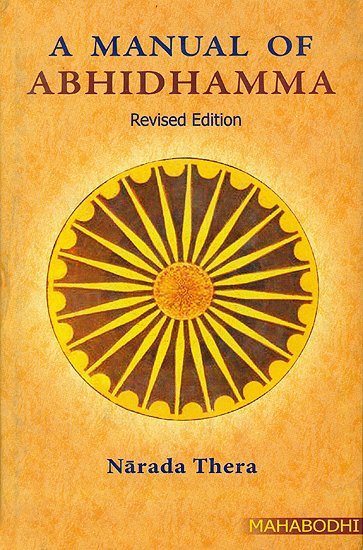A Manual of Abhidhamma
by Nārada Thera | 80,494 words | ISBN-13: 9789380336510
In the Abhidhammattha Sangaha there is a brief exposition of the Law of Dependent Origination, followed by a descriptive account of the Causal Relations that finds no parallel in any other philosophy. Edited in the original Pali Text with English Translation and Explanatory Notes by Narada Maha Thera....
§ 8.
(arūpāvacara kusala cittāni-4)
- ākāsānañcāyatana-kusalacittam,
- Viññānañcāyatana-kusalacittam,
- ākiñcaññāyatana-kusala,
- N'eva-saññā-n'āsaññāyatana-kusalacittañ c'ati.
Imāni cattāri'pi Arūpāvacara-kusalacittāni nāma.
(arūpāvacara vipāka cittāni)
- ākāsānañcāyatana-vipākacittam,
- viññānañcāyatana-vipākacittam,
- ākiñcaññāyatana-vipākacittam,
- N'eva-saññā-n'āsaññāyatana-vipākacittam c'ati.
Imāni cattāri'pi arūpāvacara-vipākacittāni nāma.
(arūpāvacara kriyā cittāni-4)
- ākāsānañcāyatana-kriyācittam,
- viññānañcāyatana-kriyācittam
- ākiñcaññāyatana-kriyācittam,
- n'eva-saññā-n'āsaññāyatana-kriyācittañ c'ati.
Imāni cattāri'pi arūpāvacara-kriyācittāni nāma.
Icc' evam sabbathā'pi dvādasa arūpāvacara-kusala-vipāka-kriyācittāni samattāni.
ālambanappabhedhena - catudhā'ruppamānasam
Puññapākakriyābhedā - puna dvādasadhā thitam.
(translation)
§ 8.
(Formless-Sphere Moral Consciousness - 4)
- Moral Jhāna consciousness dwelling on the "Infinity of Space",[1]
- Moral Jhāna consciousness dwelling on the "Infinity of Consciousness",[2]
- Moral Jhāna consciousness dwelling on "Nothingness",[3]
- Moral Jhāna consciousness wherein "Perception neither is nor is not".
These are the four types of arūpa-jhāna Moral consciousness.
(Formless-sphere Resultant Consciousness - 4)
- Resultant Jhāna-consciousness dwelling on the "Infinity of Space".
- Resultant Jhāna-consciousness dwelling on the "Infinity of Consciousness",
- Resultant Jhāna-consciousness dwelling on "Nothingness",
- Resultant Jhāna-consciousness wherein "Perception neither is nor is not".
These are four types of arūpa-jhāna Resultant consciousness.
(Formless-sphere Functional Consciousness - 4)
- Functional Jhāna-consciousness dwelling on the "Infinity of Space".
- Functional Jhāna-consciousness dwelling on the "Infinity of Consciousness".
- Functional Jhāna-consciousness dwelling on "Nothingness" .
- Functional Jhāna-consciousness wherein "Perception neither is nor is not".
- These are the four types of arūpa-jhāna Functional consciousness.
Thus end, in all, the twelve types of Arūpa Jhāna Moral, Resultant, and Functional consciousness.[4]
Arūpa-jhāna consciousness is fourfold, classified according to the objects. Again they stand at twelve according to Moral, Resultant, and Functional types.
Notes:
44. Arūpa Jhāna-
The Yogi who has developed the Rūpa Jhānas and who wishes to develop the Arūpa Jhānas now concentrates on the Patibhāga Nimitta mentioned in the previous section. As he does so, a faint light, like a fire fly, issues from the Kasina object. He wills it to expand until it covers the whole space. Now he sees nothing but this light pervading everywhere. This developed space is not a reality but a mere concept. In Pāli this space is called kasinugghātimākāsa (space issuing forth from the Kasina object). On this concept he concentrates thinking "ākāso ananto", 'Infinite is space', until he develops the first Arūpa Jhāna-ākāsānañcāyatana.
As in the case of the Rūpa Jhānas a thought-process, runs as follows:-
mano-dvārāvajjana, parikamma, upacāra, anuloma, gotrabhū,
ākāsānañcāyatana.
Parikamma thought-moment may or may not occur.
The Arūpa Jhāna thought-moment occurs only for a moment, and then the consciousness lapses into Bhavanga consciousness.
Again he concentrates on the first Arūpa Jhāna thinking "viññānam anantam", 'Infinite is Consciousness' until he develops the second Arūpa Jhāna - "viññānañcāyatana".
To develop the third Arūpa Jhāna - "ākiñcaññāyatana" - the Yogi takes for his object the first Arūpa Jhāna consciousness and thinks - 'Natthi kiñci', "There is nothing whatever".
The fourth Arūpa Jhāna consciousness is developed by taking the third Arūpa Jhāna consciousness as the object. The third Arūpa Jhāna is so subtle and refined that one cannot definitely say whether there is a consciousness or not. As he concentrates thus on the third consciousness he develops the fourth Jhāna. Although the term "saññā" is used here, vedanā, (feeling) and sankhārā, (mental states) are also included therein.
The five Rūpa Jhānas differ according to the Jhāna factors. These four Arūpa Jhānas, on the other hand, differ according to the objects of concentration. The first and the third have two concepts (paññatti). They are the concept of the 'infinity of space' and the concept of 'nothingness'. The second and the fourth Jhāna consciousness have for their objects the first and the third Jhāna respectively.
These four Arūpa Jhānas have their corresponding effects in the Arūpa spheres. The four Kriyā Jhānas are experienced only by Buddhas and Arahats.
In all these twelve Jhāna Cittas are found the two Jhāna factors - Upekkhā and ekaggatā - equanimity and one-pointedness that constitute the fifth Rūpa Jhāna.
Footnotes and references:
[1]:
[ākāsānañcāyatana = ākāsa + ananta + āyatana. Ananta + ya = anantya = anañca = end-lessness. ākāsa + anañca = ākāsānañca + āyatana is used here in the sense of abode (adhitthānatthena)]
[2]:
[viññānañcāyatana-viññāna + ananta + ya = viññānanatya = viññānañca]
[3]:
[ākiñcaññāyatana-akiñcanassa bhāvo = ākiñcaññam]
[4]:
[Both Rūpa and Arūpa Cittas are collectively termed "Mahaggata" which literally, means 'great-gone-to', i.e., developed.]
